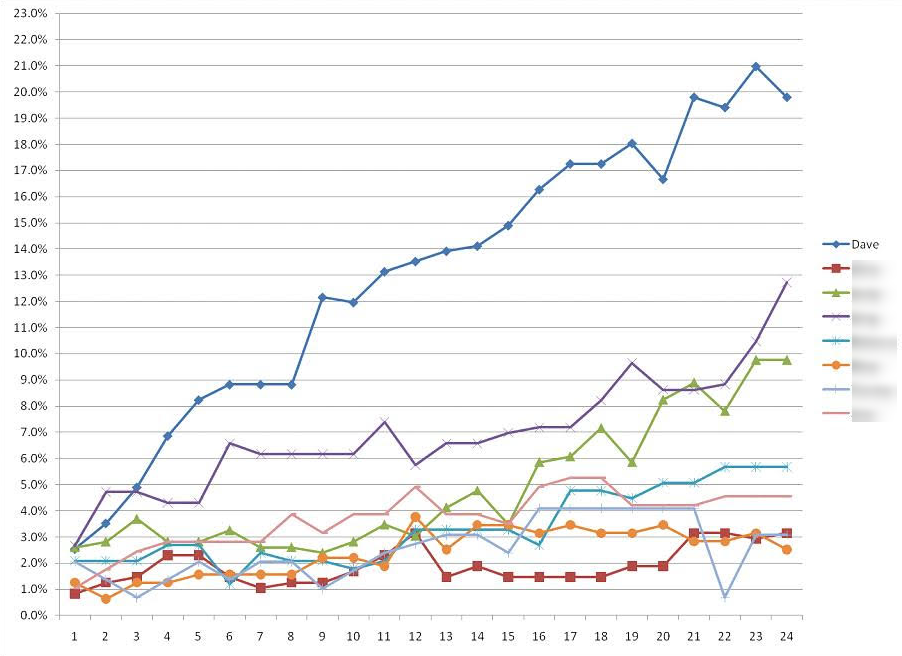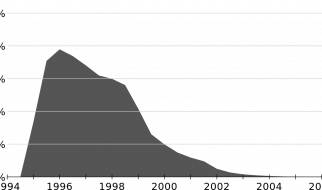Five years later, I?ve kept it off and lost even more
[Editor?s Note: Two common approaches to intermittent fasting include eating windows, where you fast for 16 or 20 hours every day, and 5:2, where you eat normally five days a week and fast the other two. We recently published a quantified-self piece on eating windows. As the title says, this piece is about 5:2 fasting.]
 Photo: Creative Commons License (www.pexels.com)
Photo: Creative Commons License (www.pexels.com)
I had struggled since college with my weight. I was still carrying around excess weight from high school football. I played on the offensive line, where tipping the scales past 250 pounds was considered a good thing.
I didn?t like the way I looked, I felt sluggish, and I wanted to change.
One day in the summer of 2011, while reading a weight-lifting site, I saw someone mention an intermittent-fasting plan. I checked it out and gave it a shot. The idea was to eat normally five days a week, and then restrict calories two days a week. Now people refer to this as the 5:2 variant of intermittent fasting.
Around the same time, people in my office started a weight-loss competition. The winner would be whoever lost the highest percentage of their starting weight over a six-month period. Everybody pitched in $20, and the winner would take the entire pool. That was extra motivation.
Over the course of six months, I crushed it: I lost 50 pounds. I had a new lease on life. I felt like I had been freed from the belief that I couldn?t lose weight. I felt a feeling of control.
The competition ended in December 2011. I won the office pool ? $220 cash. A lot of people have two big criticisms of dieting. One is that diets don?t tend to work. The other is that if a diet does work, the weight loss is temporary. People call this yo-yo dieting, in that you lose a few pounds, gain a few pounds, and often end up heavier than when you started.
I?m just one person, but my experience is that since 2011, I?ve varied between periods of maintaining my weight and periods of gradual weight loss. Today I weigh 180 pounds, so I lost weight and kept it off.
![]()
 Weight tracking graph from the weight-loss competition (% starting weight lost versus weeks).
Weight tracking graph from the weight-loss competition (% starting weight lost versus weeks).
I lost 19.8 percent of my starting weight. My secret was creatively skipping meals according to a plan I had found on a website called Eat Stop Eat.
This is also an ebook you can find online, but the gist is this:
Skip eating for one to two 24-hour periods per week. When you resume eating, eat normally and resist the urge to compensate for the missed eating period.
There?s a subtleness in how you interpret a 24-hour fast. Some people think it means you don?t eat anything on fasting days. But the advice intends for you to follow the literal interpretation: You fast for 24 hours, from dinner one day to dinner the next day (or possibly from breakfast to breakfast).
![]()
Paying Your Calorie Debt
Intermittent fasting helped me to think about excess fat on my body as monetary debt. Going into a calorie deficit is payment on that debt. It?s like making a credit card payment.
The most common approach to eating less than you burn is to ?watch what you eat? or to eat at a low-grade calorie deficit all the time. At every meal, eat about 10 to 20 percent fewer calories than you need in order to maintain that deficit, which requires your body to dip into its reserves and burn excess fat. This can be mentally difficult, because you always have to be restricting calories.
I find this approach to be nearly impossible just from the perspective of willpower. That?s why I weighed 250 pounds.
Intermittent fasting provides a different path to creating a caloric deficit. Skipping two 24-hour periods of eating works out like this over the course of my week:
- Sunday: 3 meals
- Monday: 3 meals
- Tuesday: 1 meal [FASTING DAY]
- Wednesday: 3 meals
- Thursday: 3 meals
- Friday: 1 meal [FASTING DAY]
- Saturday: 3 meals
A normal week of three meals per day results in 21 meals. A week that contains two fasting days results in 17 meals, or four fewer meals altogether.
In the competition, I lost 19 percent of my body weight. Coincidentally, the math on four skipped meals per week works out to a 19 percent calorie deficit:
4 meals skipped / 21 possible meals = 19% reduction ![]()
Why Is Intermittent Fasting Easier Than Regular Dieting?
It?s easier because it?s simpler. I went about my week and ate normally. There are only two days when I abstained from eating for most of the day, which can be a little tough at first, but I got used to it.
On my fasting days, I would wake up, have coffee, and start my day without any food. This would continue until about 5:30 p.m., when I would prepare a dinner that didn?t vary from my regular dinner in terms of either what or how much I ate. So, my fasting dinner would be something normal for me, like stir-fry, pasta, soup, sandwich, sushi, etc. This dinner looked like any other and occurred at the usual time. This made it simpler ? I was just resuming eating with no special fanfare.
Abstention is easier than moderation. Ever try to eat just the recommended serving of potato chips? It?s really hard for most of us. Intermittent fasting lets you abstain completely so you can enjoy food later without feeling the pain of constant restriction.
We all know what it feels like to crack under the pressure of a diet. You feel the constant pressure to not eat that thing?that thing you really love. Constantly thinking about what you can?t eat is exhausting.
Intermittent fasting lets you skip the mental anguish of constant deprivation. Eat the things you want to eat and still create a caloric deficit.
I?m not trying to convince you to try intermittent fasting. Rather, I know a lot of people are already trying it. So, I want to share with those of you who are already interested the keys parts of my experience that made fasting easier and more successful.
![]()
Keys to Intermittent Fasting
Fasting isn?t magic ? you still need to follow some basic principles. Here are the key points that tripped me up when I started:
- Calories still matter. Fasting does not give you a free pass to gorge; you still need to create that overall caloric deficit. Get comfortable with your daily calorie allowance. Learn your basal metabolic rate (BMR) and total daily energy expenditure (TDEE). More on that in a bit.
- It takes some getting used to. That feeling you get when you haven?t eaten in four hours is not actual hunger ? it?s a learned physiological response. When you?re used to eating all the time, it can be uncomfortable to break that cycle at first. That feeling goes away?or, at least, decreases drastically?after the first one or two weeks.
- It?s flexible. If friends invite you out for a meal at the last minute, you don?t have to say no because you?re fasting. You can enjoy that meal with friends and move your fasting day to another day in the week.
- Whole plant foods make this even better. My experience was that when I started adding in a ton more fiber- and nutrient-dense foods, my cravings, headaches, and irritability went away. It also became much easier to feel fuller on fewer calories, making my calorie deficit that much easier to achieve.
![]()
Key #1: Count Calories at the Beginning
I recommend counting calories?not forever, but for about two weeks?so you get a feel for what a regular day of eating feels like. I have used and like Cron-o-meter, Lose It!, and Fitbit to track calories. Don?t get bogged down in the details. If a type of food you ate is not in the database, find something similar or make an educated guess. You just want to make sure you?re in the ballpark.
You need to understand that your handful of almonds is a healthy snack, to be sure, but it?s also worth anywhere from 140 to 160 calories. Getting to this level of comfort estimating your calories is the key so you know when you are overdoing it.
Your Basal Metabolic Rate and Total Daily Energy Expenditure
Basal metabolic rate (BMR) is the amount of energy you burn by just being you?the energy required to keep you alive. This does not include energy needed to exercise or to perform any other physical activities. Total daily energy expenditure (TDEE) is your BMR plus any energy used above and beyond due to your physical activity.
This BMR calculator uses just your weight, height, age, and gender. Your TDEE is based on your BMR, and then you tack on a multiplier based on your level of physical activity. With your BMR, you can now calculate your TDEE with the Harris Benedict Equation. (It?s easy?just click through.)
Why Are BMR and TDEE Important?
They are important at the beginning because you need to ensure that you aren?t overcompensating for your fast days during your regular eating days.
When I started intermittent fasting, I spent a lot of time thinking about how I wasn?t eating. I would think about how hungry I was, and then, when it came time to break my fast, I would eat more than a regular dinner, thinking I deserved it after having fasted all day. This is how people fail at intermittent fasting. It took me about two weeks to figure it out.
![]()
Key #2: Learn the Difference Between True Hunger and Toxic Hunger
During my first few days of experimenting with intermittent fasting, at around 9 a.m. I would feel this intense hunger pain in my chest and throat. Around 11 a.m., I felt it again, this time with a headache and a grumbling stomach. I worried that I wouldn?t make it through the day.
Then, around 2 p.m., I felt nothing. The pain was gone, and I felt completely fine. After some researching, I discovered an explanation that rang true to me: What we think of as hunger is really just your body?s learned response to constant feeding. Dr. Joel Fuhrman explains it like this:
I propose that these sensations are actually symptoms of detoxification and withdrawal from an unhealthy diet, lacking in crucial micronutrients. I call this Toxic Hunger.
After two weeks, I didn?t feel the effects of toxic hunger at all. This time period may be different for everyone, but being aware that these unpleasant symptoms will eventually diminish is key to sticking with intermittent fasting.
Also, coffee (without cream or sugar) really helped during this period. Coffee has a natural appetite-suppressing effect, and caffeine can help with mild headaches.
![]()
Key #3: Allow Yourself Flexibility
One of the best parts of intermittent fasting instead of general calorie restriction is that you can easily fit it into your life.
When I planned to fast on a Thursday, but my colleagues planned to go out to eat, I would join them, eat what I wanted within reason, and simply move my fasting day to Friday. This helps avoid conversations about why you aren?t eating or why you don?t join in.
My other options were to skip going out or to try flexing my willpower so I ate just a tiny bit of something or something I didn?t want. Historically, that has been nearly impossible for me.
This flexibility helped make the diet easier and helped me avoid situations where I felt like I?d failed.
![]()
Key #4: Eat More Whole Plant Foods
Eating fewer calorie-dense, higher-nutrient foods and focusing on increasing my fiber intake really helped me. Fiber helps fill you up with fewer calories ? this meant I focused first on unprocessed fruits, vegetables, grains, and legumes before filling up on higher-calorie, higher-fat foods.
This helped me have fewer cravings during the introductory period. It also meant I felt like I could eat a ton of food.
This isn?t a requirement of intermittent fasting?by all means, you can eat what you prefer. This is just what helped me to lose weight and maintain that loss.
![]()
Additional Benefits of Intermittent Fasting
Many additional benefits to intermittent fasting are not necessarily present with generic calorie restriction, such as improved focus, reduced inflammation, and faster recovery from exercise.
Improved Mental Energy
My favorite benefit, beyond weight loss, was that I had to spend less mental energy on food. When I don?t need to make breakfast or pack a lunch, I save some mental capacity that I can use productively elsewhere.
Sustainable
Another plus is that this is easily the most sustainable eating plan I?ve ever come across. You don?t need to fast forever to maintain the benefits ? you can fast for a time and stop when you reach your goal weight. But if your weight creeps up, you can add in one fasting day per week to head it off, rather than going into full-blown ?emergency calorie-restriction? mode.
More Resources
If you?re curious about intermittent fasting, check out Eat Stop Eat, LeanGains, Precision Nutrition, and an active subreddit that I refer to often.
Coach.me is another fantastic resource that I?ve used to maintain healthy habits (some for more than 560 days). It helps you build habit streaks, find others doing the same, and get personalized coaching. [Editor?s note: I?m the founder of Coach.me and would have taken this out if not for the bit about the writer?s streaks. I?m not commissioning these articles to pitch our product, but I think the bit about multiyear streaks is a relevant part of his story.]
As always, before making significant changes to your diet or lifestyle, be sure to consult your physician.


